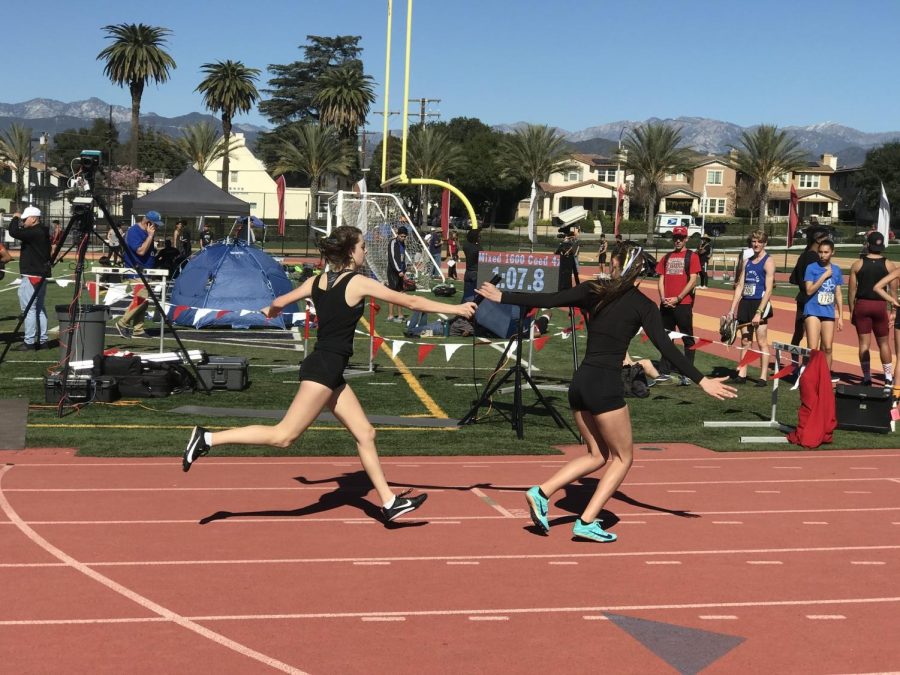Coed 4×400-meter relay hurdles tradition as a new event
Californian athletes hand off the baton in the Mixed 4×400-Meter Relay at a qualifying meet in Covina for the California Winter Track & Field Championships. New to high school winter and indoor track competitions, the event will also be run at the upcoming Olympic Games in Tokyo.
With such controversy surrounding gender-separated sports in today’s day and age, one may be left wondering what progress society has made to create sporting events more inclusive. The world of sports, from the professional level to the high school one, has taken a step forward via the addition of a coed relay. Officially titled the “Mixed Gender 4×400-Meter Relay,” the new event will be added into the 2020 Olympics in Tokyo and most levels of competitive track, and it was already added to the California Winter Track and Field Championships (which CHS athletes compete in annually).
“I believe that the new 4×400 relay is a very positive thing for track and field as a whole since it allows both male and female athletes to compete together, something that has not happened before in my sport,” sophomore and track athlete Theo Chinn said. “I wouldn’t be surprised to see this event become very popular in coming years.”
The event itself is different from anything the Olympics or the world of competitive track has seen before. With two men and two women participating in the relay, sports analysts predict it will become an exciting event for spectators. This is due to a crucial element of the relay: teams are able to field their athletes in whatever order they see fit. Participants’ freedom to determine the order of relay runners is where the event gets interesting, as many analysts argue this creates more excitement because the gap between the world’s best male and female 400m runners is around six seconds. This is a notable difference over the course of 400 meters. Thus, if a runner is against one of the opposite gender, it will create opportunities for dramatic takeovers. While some argue this does not matter, as there remains an even mix of men and women, the majority of analysts argue that placement of runners has a huge impact on intimidation factors as well as a difference in the speed of lead and anchor runners.
This addition also creates a more diverse array of options for athletes who believe sports should not be completely divided into gender-based categories. Being competitive track’s first ever coed event, the relay offers a unique opportunity for female and male athletes to collaborate and compete on the same playing field.
“The new relay will open many doors for gender inclusivity as women don’t get as much recognition in sports as they should,” sophomore and track athlete Maisie Zurbuch said. “Putting together a coed team will only physically push the athletes further and bring new ideas to sports as a whole.”
The event was already implemented in the 2019 Doha World Championships. As the event made its competitive debut, Team USA took home first place, as well as setting a world record-breaking mark of 3:09:34. Trailing close behind were teams from Jamaica, Bahrain, and Great Britain & Northern Ireland. The presence of the event at the world championships was promising for the future of the mixed relay, which is already rather concrete seeing as the event will be added to both the 2020 Olympics and most levels of competitive track.
Standing to defy standards and include cohesive competition between men and women, the new 4×400 mixed relay is speculated to become a popular one. From the big leagues of Olympic arenas to the packed bleachers of high school track and field competitions, the event is making history.
Hello there! Our goal is to provide relavent, engaging journalism for readers of all ages. Your donation will support the student journalists of the Wolfpacket at Claremont High School, and will allow us to purchase equipment, print our monthly issues, and enter in journalism competitions. We appreciate your consideration!

The 2020-2021 school year marks Ady Bolinger’s second year on the Wolfpacket staff. Bolinger, a junior at Claremont High School, holds an editorial position...

Sequoia Clark is a senior at CHS, and the head Editor-In-Chief for the Wolfpacket. She enjoys writing unnecessarily long articles about Taylor Swift, and...













